Improve Sleep with These Nutrient-Rich Foods
Struggling to get a good night’s sleep? You’re not alone. With less than two-thirds of us (63%)[1] regularly enjoying enough sleep, many people are looking for natural ways to improve their rest. The good news is that what you eat can have an impact on your sleep quality!
A good night’s sleep offers a number of possible physical and mental benefits – including helping regulate mood and reduce stress levels, improving memory, helping maintain weight and energy levels and supporting good heart health[2] [3].
The good news is that what you eat can have a big impact on the quality of your sleep, with foods such as dark green leafy veg like kale and cavolo nero, beans and pulses, wholegrains, oily fish and nuts and seeds all helping support this.
These foods contain key nutrients that help support the production of melatonin- the hormone that controls our circadian rhythm, and serotonin, a brain chemical that helps regulate sleep.
Here, Expert Nutritionist and Dietitian for Discover Great Veg, Jo Travers shares the top 5 foods for supporting a good night’s sleep, as well as five sleep-supporting evening meal recipes featuring these foods, from Discover Great Veg. As Jo says, “With so many of us struggling to get enough sleep, it’s great to know that the food we eat can make a big difference. Enjoying a diet rich in dark green leafy veg such as kale and cavolo nero, as well as beans and pulses, fruit, wholegrains, oily fish and nuts and seeds will ensure you are getting enough of the important nutrients which are needed for good quality sleep. So why not try adding more of these to your diet?”
1. Kale
Dark green leafy vegetables like kale are a great source of multiple minerals which can be useful for sleep. Kale is a source of potassium – a nutrient which can support sleep quality and duration[4] and the dark green leafy veg is also a good source of iron and calcium - both of which are involved in the production of serotonin[5] [6] in the body. Kale is also a source of fibre, which has been shown to improve sleep quality[7].
3. Oily fish
Fish like salmon, mackerel, sardines and herring are high in omega 3, which is an important part of the membrane of the pineal gland in the brain, where melatonin is produced[8]. Low blood concentrations of omega 3s are associated with poor sleep quality[9], so adding foods rich in this to your diet can help.
3. Beans and lentils
Beans, pulses and legumes are sources of tryptophan and carbohydrates - the combination of which increases tryptophan levels in the brain, allowing extra serotonin and melatonin to be made[10]. They also contain vitamins B5[11] and B6[12], which have been shown to increase sleep quality and duration and minerals like calcium[13], potassium[14], iron[15] and magnesium[16] which all play a part in good sleep. Legumes are a great source of fibre too – which can help improve sleep quality[17].
4. Nuts
Some nuts like pistachios and almonds[18] contain melatonin which is available for the body to use, but all nuts contain vitamin B5 which is involved in the production of melatonin[19] in the body. Nuts are also a source of magnesium, which is involved in the production of melatonin and suppresses the ‘wake-up’ hormone[20] cortisol.
5. Sour cherries
Sour cherries are another food that contains melatonin, and several studies have shown that eating this type of cherry, or drinking the juice, can improve sleep, especially in older adults[21].
Try these sleep-boosting recipes
Looking for delicious ways to incorporate these foods into your meals? We have 5 tasty, nutritious recipes that can help you get the rest you need.
Veggie fajitas with cavolo nero
Prep: 5 minutes
Cook: 15 minutes
Serves 4
![]()
4 flour or corn tortillas
2 red onions, sliced into strips
1 tbsp veg oil
3 cloves garlic, sliced
1 tsp ground cumin
2 tsp smoked paprika
Add pinch chilli flakes
1 tsp ground coriander
2 peppers, cut into slices.
1 240g tin black beans, drained and rinsed
2 tbsp sun dried tomato paste
200g bag of cavolo nero
1 ripe avocado, sliced
3 tbsp reduced fat sour cream
Instructions
1. Pre heat oven to 180C and wrap 4 medium tortillas in foil.
2. Firstly slice the onion into strips then add it along with the oil to a frying pan. Fry on a medium heat for 7-8 minutes until soft.
3. Now add the garlic and spices and stir to combine and cook for a minute, then add the pepper to the pan. Cook for 5 minutes, then add the black beans, sun dried tomato paste and cavolo nero.
4. Stir and cook for a further 2-3 minutes.
5. Meanwhile, put the tortillas in the oven to heat up for 5 minutes.
Season to taste. Serve the tortillas with the fajita mix, avocado and soured cream.
Salmon with Soy, Cavolo Nero & Sushi Rice
Prep: 10 minutes
Cook: 20 minutes
Serves 2
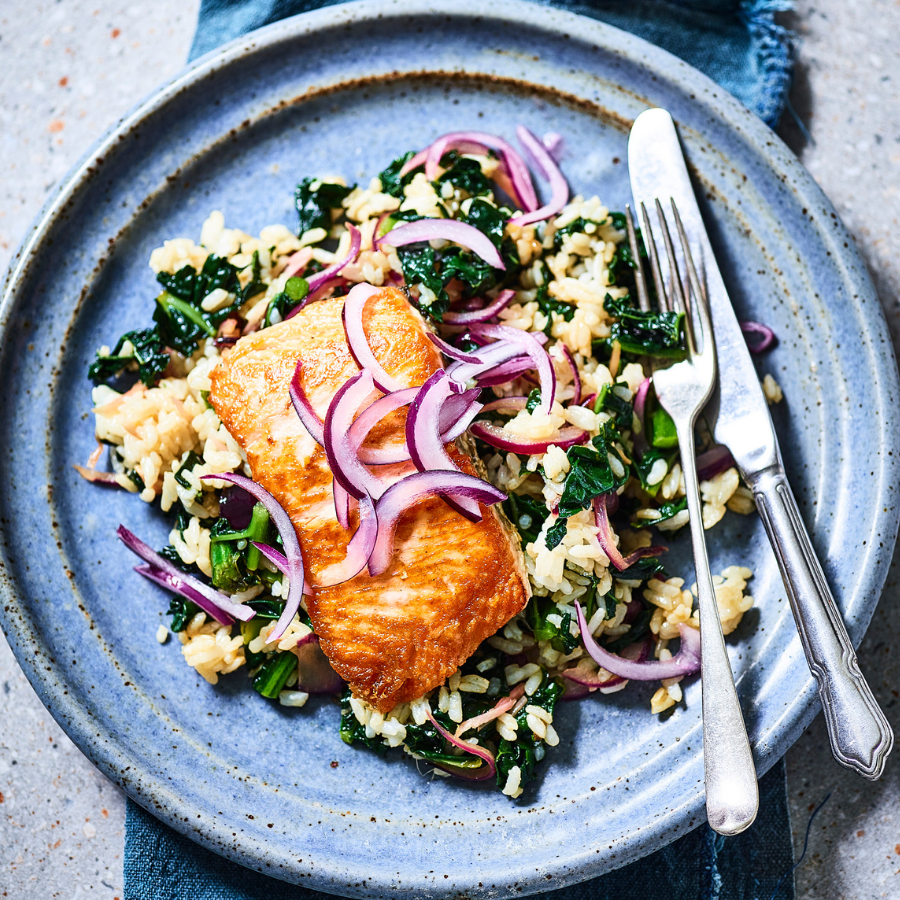
½ small red onion, sliced
25g sushi ginger, shredded, plus 1 tbsp pickling juice
125g sushi rice
1 tbsp vegetable oil
2 salmon fillets
125g thick cut cavolo nero
2 tsp toasted sesame oil
1 tbsp soy sauce
Instructions
1. Mix the onion with the ginger juice and set aside.
2. Place the rice, 250ml water and a pinch salt in a small saucepan, cover and cook on a low heat for 15-20 minutes until just tender, leave the lid on and set aside.
3. Meanwhile, heat the vegetable oil in a frying pan and fry the salmon for 10 minutes, turning halfway until cooked through.
4. Cook the cavolo nero in boiling water for 3-4 minutes, drain well. Heat the sesame oil in a frying pan and fry half the onion for 2 minutes, add the ginger, cavolo nero, rice and soy and stir fry for 1-2 minutes.
5. Serve the salmon on top of the rice mixture and scatter with the remaining onion.
Cavolo Nero & Chickpea Falafels with Harissa
Prep: 10 minutes
Cook: 10 minutes
Serves 2
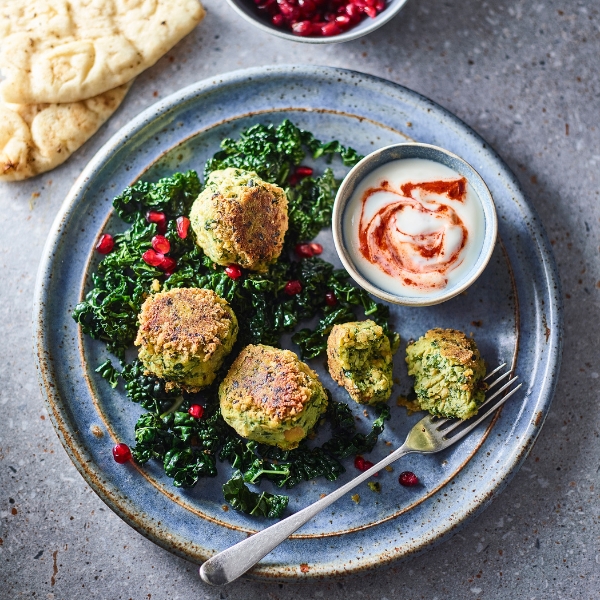
400g can chick peas, drained and rinsed
200g pack Cavolo Nero, thick stalks removed
1 tbsp tahini
1 clove garlic
½ tsp ground cumin
½ tsp ground coriander
2 tbsp vegetable oil
100g yogurt alternative
1 tsp harissa paste
Ingredients
1. Place the chick peas in a food processor with the leaves from 2 stems Cavolo Nero, roughly chopped, the tahini, garlic and spices and blend to a coarse paste, season well.
2. Divide into 8 and roll into balls.
3. Heat the oil and fry the falafels for 2-3 minutes until golden, turning once half way.
4. Remove and add the remaining Cavolo Nero, shredded and fry for 2-3 minutes, season.
5. Meanwhile, mix together the yogurt and harissa.
6. Serve the falafels onto the Cavolo Nero and drizzle with the harissa yogurt.
Chicken, Kale and Butter Bean Stew
Prep: 5 minutes
Cook: 30 minutes
Serves 4
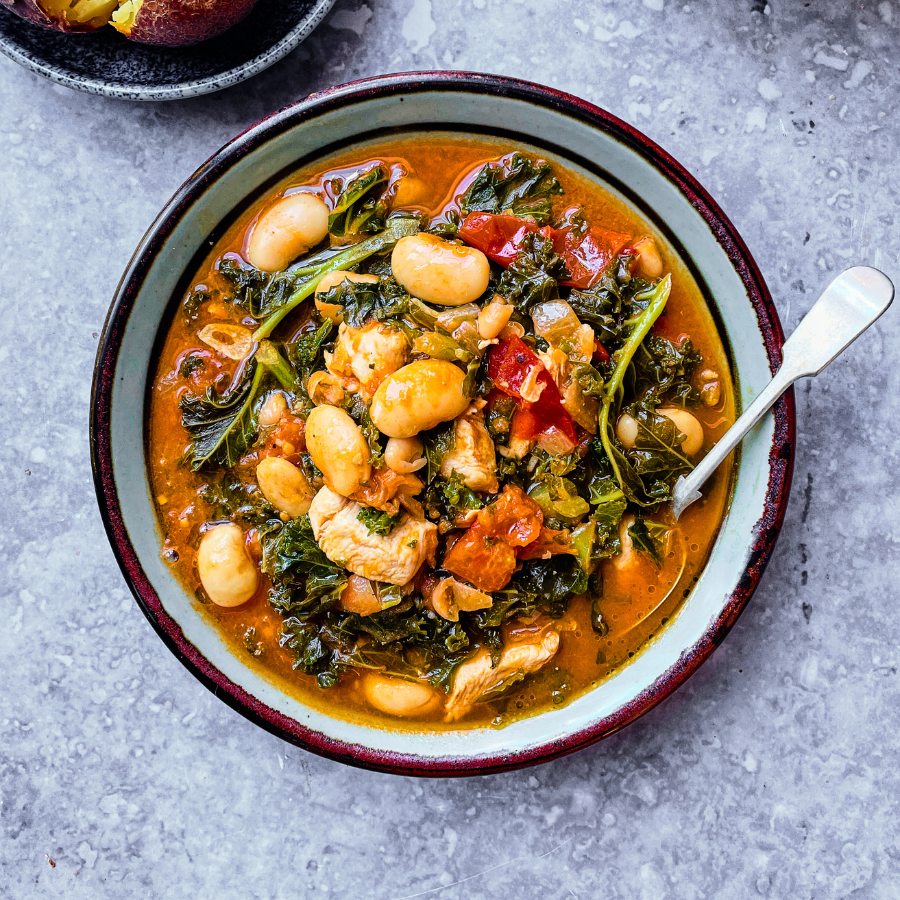
2 tbsp olive oil
2 chicken breasts, chopped
1 onion, roughly sliced
3 cloves garlic, roughly chopped
1 tbsp smoked paprika
6 large tomatoes, chopped
1 tbsp red wine vinegar
550ml vegetable stock
500g butter beans, drained
250g bag of kale, chopped
Serving suggestion -- Jacket potatoes
Ingredients
1. Add 1 tbsp of olive to a large pan, add the chicken and cook for a few minutes each until lightly golden brown. Remove the chicken and set aside.
2. Now add the onion and remaining oil to the pan and cook for approx 10 minutes until soft.
3. Add the garlic and smoked paprika to the pan and cook for a further minute.
4. Now add in the chopped tomatoes and vinegar, cook for a few minutes until they are soft then add the stock. Simmer for 5 minutes.
5. Add in the beans, chicken and kale. Cook for a further 10 minutes.
6. Season to taste. Serve the stew with the jacket potatoes on the side.
Dhansak with Chickpeas and Kale
Prep: 10 minutes
Cook: 30 minutes
Serves 4
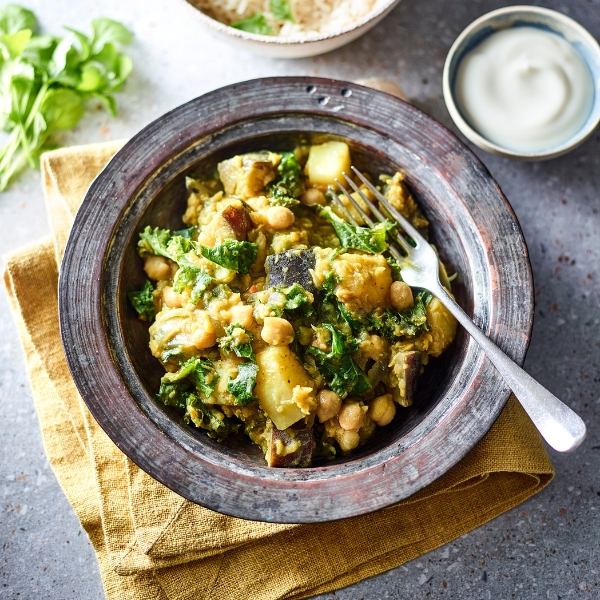
1 tbsp vegetable oil
1 Red Onion, sliced
350g potatoes, diced
1 aubergine, diced
1 tbsp medium curry powder
400g can chick peas, drained and rinsed
200g red split lentils
800ml vegetable stock
250g bag Kale, thick stalks removed
Plain vegan yogurt alternative to serve
1. Heat the oil in a large saucepan and fry the onion for 3 minutes, add the potatoes and aubergine and fry for a further 2-3 minutes.
2. Stir in the curry powder then stir in the chickpeas and lentils. Add the stock, bring to the boil and cook, covered for 15 minutes, stirring occasionally.
3. Add the Kale and cook for a further 5 minutes. Season to taste and serve with a little yogurt alternative.
References
[4] Li M, Heizhati M, Wang L, Wang Z, Abudoureyimu R, Yang Z, Pan F, Sun L, Li W, Li J, Lin M, Gan L, Lu S, Li N. 24-hour urinary potassium excretion is negatively associated with self-reported sleep quality in the general population, independently of sleep-disordered breathing. J Clin Sleep Med. 2022 Nov 1;18(11):2589-2596. doi: 10.5664/jcsm.10168. PMID: 35912683; PMCID: PMC9622988.
[5] Maymona Al Hinai, Erica C Jansen, Peter XK Song, Karen E Peterson, Ana Baylin, Iron Deficiency and Vitamin D Deficiency Are Associated with Sleep in Females of Reproductive Age: An Analysis of NHANES 2005–2018 Data, The Journal of Nutrition, Volume 154, Issue 2, 2024,Pages 648-657
[6] [6] Zawilska JB. The role of calcium in the regulation of melatonin biosynthesis in the retina. Acta Neurobiol Exp (Wars). 1992;52(4):265-74. PMID: 1293965.
[7] Zuraikat FM, Makarem N, St-Onge M-P, Xi H, Akkapeddi A, Aggarwal B. 2020. A Mediterranean dietary pattern predicts better sleep quality in US women from the American Heart Association Go Red for Women strategically focused research network. Nutrients 12:2830
Muscogiuri G, Barrea L, Aprano S, FramondiL, Di Matteo R et al. 2020. Sleep quality in obesity: Does adherence to the Mediterranean diet matter?. Nutrients 12:1364
[8] Lavialle M, Champeil-Potokar G, Alessandri JM, Balasse L, Guesnet P, Papillon C, Pévet P, Vancassel S, Vivien-Roels B, Denis I
An (n-3) polyunsaturated fatty acid-deficient diet disturbs daily locomotor activity, melatonin rhythm, and striatal dopamine in Syrian hamsters. J Nutr, 138 (2008), pp. 1719-1724
[9] Erica C Jansen, Deirdre A Conroy, Helen J Burgess, Louise M O'Brien, Alejandra Cantoral, Martha María Téllez-Rojo, Karen E Peterson, Ana Baylin, Plasma DHA Is Related to Sleep Timing and Duration in a Cohort of Mexican Adolescents, The Journal of Nutrition, Volume 150, Issue 3, 2020, Pages 592-598,
[10] Fernstrom JD. 2013. Large neutral amino acids: dietary effects on brain neurochemistry and function. Amino Acids 45:419–30
[11] Bell D, Vitamin B5 deficiency. Reference article, Radiopaedia.org (Accessed on 24 Feb 2025) https://doi.org/10.53347/rID-6... DOI: https://doi.org/10.53347/rID-69947
[12] Stover PJ, Field MS. Vitamin B-6. Adv Nutr. 2015 Jan 15;6(1):132-3. doi: 10.3945/an.113.005207. PMID: 25593152; PMCID: PMC4288272.
[13] Zawilska JB. The role of calcium in the regulation of melatonin biosynthesis in the retina. Acta Neurobiol Exp (Wars). 1992;52(4):265-74. PMID: 1293965.,
[14] Li M, Heizhati M, Wang L, Wang Z, Abudoureyimu R, Yang Z, Pan F, Sun L, Li W, Li J, Lin M, Gan L, Lu S, Li N. 24-hour urinary potassium excretion is negatively associated with self-reported sleep quality in the general population, independently of sleep-disordered breathing. J Clin Sleep Med. 2022 Nov 1;18(11):2589-2596. doi: 10.5664/jcsm.10168. PMID: 35912683; PMCID: PMC9622988
[15] Maymona Al Hinai, Erica C Jansen, Peter XK Song, Karen E Peterson, Ana Baylin,
Iron Deficiency and Vitamin D Deficiency Are Associated with Sleep in Females of Reproductive Age: An Analysis of NHANES 2005–2018 Data, The Journal of Nutrition, Volume 154, Issue 2, 2024,Pages 648-657
[16] Held K, Antonijevic I, Künzel H, Uhr M, Wetter T, Golly I et al (2002) Oral Mg2+ supplementation reverses age-related neuroendocrine and sleep EEG changes in humans. Pharmacopsychiatry 35(04):135–143
[17] Zuraikat FM, Makarem N, St-Onge M-P, Xi H, Akkapeddi A, Aggarwal B. 2020. A Mediterranean dietary pattern predicts better sleep quality in US women from the American Heart Association Go Red for Women strategically focused research network. Nutrients 12:2830
Muscogiuri G, Barrea L, Aprano S, FramondiL, Di Matteo R et al. 2020. Sleep quality in obesity: Does adherence to the Mediterranean diet matter?. Nutrients 12:1364
[18] Annual Review Of Nutrition. Sleep and Diet: Mounting Evidence of a Cyclical Relationship. Faris M. Zuraikat1,2, Rebecca A. Wood2, Rocío Barragán1,3,4, and Marie-Pierre St-Onge1,2 Vol. 41:309-332 (Volume publication date October 2021)
[19] Bell D, Vitamin B5 deficiency. Reference article, Radiopaedia.org (Accessed on 24 Feb 2025) https://doi.org/10.53347/rID-69947 DOI: https://doi.org/10.53347/rID-69947
[20] Held K, Antonijevic I, Künzel H, Uhr M, Wetter T, Golly I etal (2002) Oral Mg2+ supplementation reverses age-related neuroen-docrine and sleep EEG changes in humans. Pharmacopsychiatry 35(04):135–143
[21] Garrido M, Gonzalez-Gomez D, Lozano M, Barriga C, Paredes SD, Rodriguez AB. 2013. A Jerte Valley cherry product provides beneficial effects on sleep quality. Influence on aging. J. Nutr. Health Aging 17:553–60
GINGER HARISSA ROASTED VEGETABLE PILAF (high in fibre: 24g of fibre per portion)
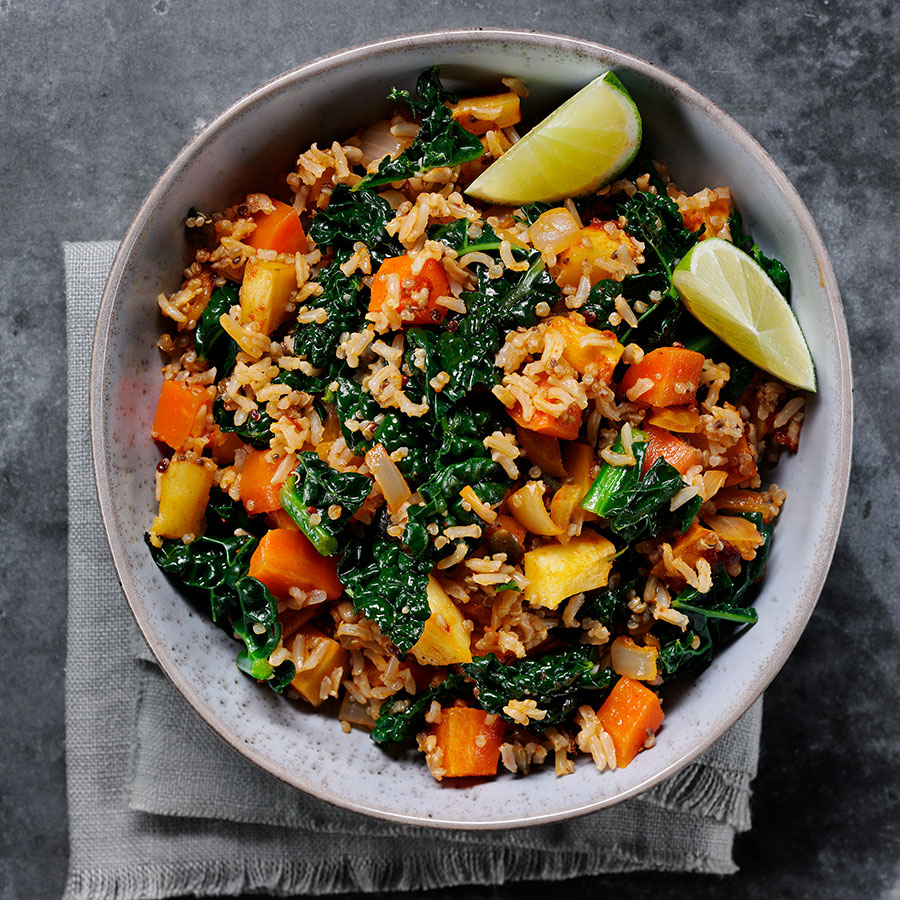
Prep: 15 minutes
Cook: 30 minutes
Serves 4
Ingredients
2 parsnips, diced
2 carrots, diced
1 onion, diced
2 tbsp olive oil
5cm piece root ginger, grated
1 tbsp harissa paste
200g pack sliced Cavolo Nero
250g pouch super seeds with quinoa & chia
200g brown basmati rice
Juice 1 lime
Yogurt to serve
Instructions
1. Preheat the oven to 200°C, gas mark 6.
2. Place the parsnips, carrot and onion on a large baking tray and toss with 1 tbsp oil, ginger and harissa, season and roast for 20 minutes. Add the cavolo nero, the seeds mix and toss in the remaining oil, roast for a further 10 minutes.
3. Meanwhile, cook the rice in boiling water for 20-25 minutes until tender and drain well.
4. Stir the rice into the vegetable mixture with the lime juice, season and serve with the yogurt.
Cooking tip: Great to use up leftover cooked rice. Try stirring in cooked prawns at the end.
WINTER KALE SALAD (21g of fibre per portion)
.png?updated=1730386333541)
Prep: 10 minutes
Cooks: 15-20 minutes
Serves 2
Ingredients
50g quinoa
2 tbsp extra virgin olive oil
1 tbsp cider vinegar
2 tsp wholegrain mustard 15g
½ x 180g pack Kale
400g can butter beans, drained and rinsed
1 red apple, cored and sliced
50g walnuts, chopped
1 ripe avocado, sliced 100g
80g cooked beetroot, cut into wedges
Instructions
1. Cook the quinoa according to pack instructions, drain and run under cold water.
2. Meanwhile, whisk together the oil, vinegar and mustard, season to taste. Massage the dressing into the kale in a large bowl until softened slightly. Add in the butter beans, apple, walnuts, avocado and beetroot.
3. Stir in the quinoa to serve.
Cooking tip: Make kale crisps with the remaining bag of kale, great as a healthy snack.
TOFU SPINACH AND BEAN SOUP (high in fibre: 19g of fibre per portion)
.png?updated=1730383403156)
Prep: 15 minutes
Cook: 30 minutes
Serves 4
Ingredients
1 corn on the cob 150g
1 tbsp olive oil
1 leek, sliced 200g
500ml vegetable stock
280g pack extra firm tofu, diced
400g haricot beans, drained and rinsed
½ x 250g bag Spinach
1 tbsp red pesto 20g
Juice half lemon
Instructions
1. Cut the kernels of corn off the core with a sharp knife.
2. Heat the oil in a large saucepan and fry the corn and leeks for 3-4 minutes until softened. Stir in the stock, tofu and beans and simmer, covered, for 5 minutes, add the Spinach until wilted.
3. Add a spoonful of pesto and a drizzle of lemon juice to serve.
Cooking tip: Try using smoked tofu and vegan pesto as an option.
CREAMY POTATO AND KALE CURRY (high in fibre: 18g of fibre per portion)
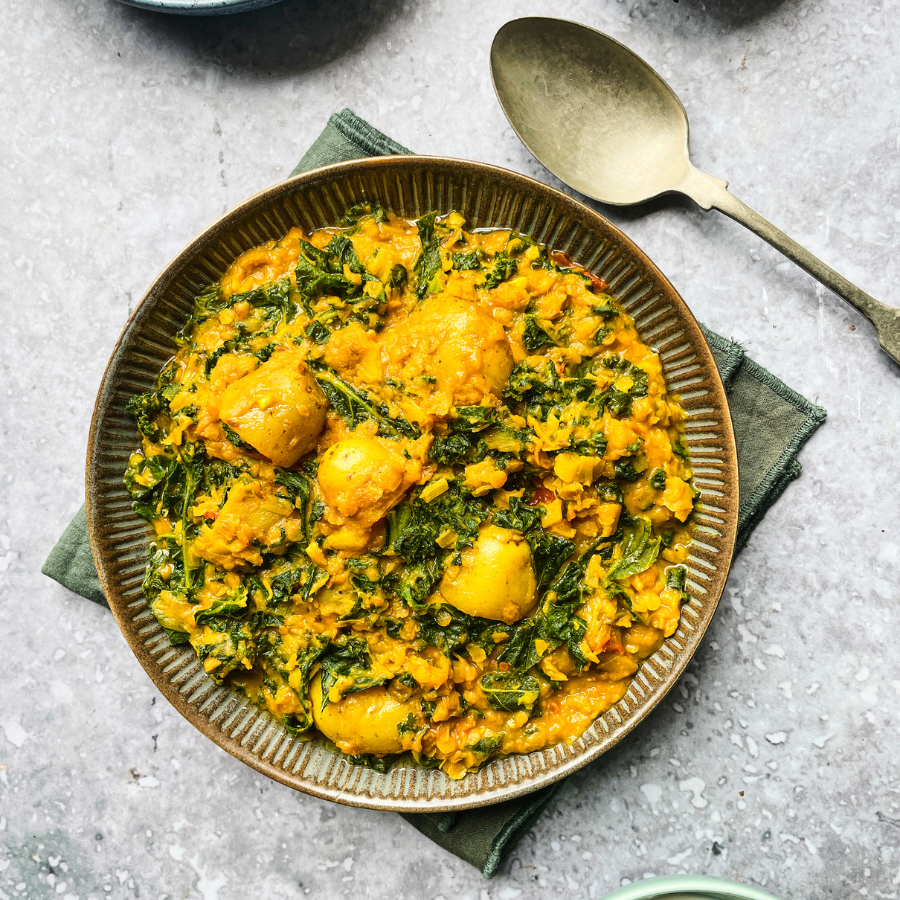
Prep: 5 minutes
Cook: 20 minutes
Serves 4
Ingredients
600g waxy potatoes, peeled and chopped into 1 inch cubes OR 600g salad potatoes (chopped in half if large)
2 tbsp veg oil
1 tsp cumin seeds
2 leeks, cleaned and trimmed
1 tsp turmeric
1 tsp ground coriander
3 garlic cloves, grated
1/2 tsp chilli flakes
5 tomatoes, roughly diced
200g red split lentils rinsed
500 ml veg stock
1 x 400ml low fat coconut milk
250g bag of kale, trimmed
1 tsp garam masala
Instructions
1. Add the potatoes in a large saucepan. Cover with boiling water and cook for 8-10 mins, or until just tender. Drain.
2. In the meantime, add the oil and cumin seeds to a frying pan. Allow them to sizzle to release their aromas.
3. Now add the leeks and remaining spices and fry for approx 5 minutes until tender.
4. Add the garlic and chilli flakes and stir to combine and fry for a further minute.
5. Add the chopped tomatoes and stir to combine.
6. Now add the red lentils, stock, coconut milk and simmer for 10 minutes.
7. Add the cooked potatoes, kale and additional water if needed (300ml) then cook for a further 5 minutes
8. Finally, season to taste and add garam masala
Cooking tip: This is a hearty and substantial dish so there’s no need for extra crabs. A vegetable side dish or raita is perfect. A great one for freezing.
KALE AND WALNUT PASTA PRIMAVERA (high in fibre: 13g of fibre per portion)
.png?updated=1730383403405)
Prep: 15 minutes
Cook: 30 minutes
Serves 4
Ingredients
250g wholewheat penne pasta
100g frozen broad beans
100g frozen peas
180g bag Kale
1 tbsp olive oil
1 leek, thinly sliced 200g
75g walnuts, roughly chopped
2 tbsp chopped chives
165g tub light cream cheese
25g Parmigiano Reggiano, finely grated, plus extra to serve
Instructions
1. Cook the pasta in boiling water for 12-13 minutes until just tender, remove with a slotted spoon and add the beans, peas and kale to the water, simmer for 4-5 minutes. Drain, reserving a little of the cooking water.
2. Meanwhile, heat the oil in a large frying pan and fry the leek and walnuts for 4-5 minutes until softened. Stir in the chives, cream cheese and the Parmesan, heat gently to melt, adding a splash of the reserved cooking water. Stir in the pasta and vegetables to evenly coat.
3. Serve sprinkled with extra Parmesan.
Cooking tips: Try any vegetables you may have in the freezer. Also a great way to use up leftover cooked vegetables.
[1] NDNS: results from years 9 to 11 (2016 to 2017 and 2018 to 2019) https://www.gov.uk/government/statistics/ndns-results-from-years-9-to-11-2016-to-2017-and-2018-to-2019
[i] Fu J, Zheng Y, Gao Y, Xu W. Dietary Fiber Intake and Gut Microbiota in Human Health. Microorganisms. 2022 Dec 18;10(12):2507. doi: 10.3390/microorganisms10122507. PMID: 36557760; PMCID: PMC9787832.
[ii] Saghafian, F., Hajishafiee, M., Rouhani, P., & Saneei, P. (2022). Dietary fiber intake, depression, and anxiety: a systematic review and meta-analysis of epidemiologic studies. Nutritional Neuroscience, 26(2), 108–126. https://doi.org/10.1080/102841...
[iii] Waddell, I. S., & Orfila, C. (2022). Dietary fiber in the prevention of obesity and obesity-related chronic diseases: From epidemiological evidence to potential molecular mechanisms. Critical Reviews in Food Science and Nutrition, 63(27), 8752–8767. https://doi.org/10.1080/104083...